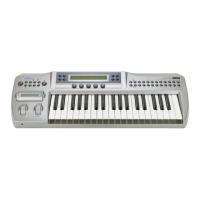• *,Oscillator types
Standard Oscillator
This simulates the oscillator
of
an
analog synthesizer. You can achieve the same effects as on
an
analog
synthesizer,
such
as Pulse
Width
Modulation.
Noise + Comb Filter
This oscillator extracts a pitched component from
white
noise.
It
can create
not
only
unique
sounds,
but
also a
wide
variety of
sounds
ranging from string-type
sounds
to
synth
bass.
VPM (Variable Phase Modulation)
This modulates the phase of two oscillators and uses the wave shaping table to process the sound to create
rich overtones.
Cross/Sync/Ring Modulation
This oscillator simulates the inter-modulation between oscillators that was possible on analog synthesizers.
Brass Model Oscillator*
3
This oscillator provides a physical model simulation
of
lip reed brass
instruments
such
as
trumpet
and
trombone.
Reed Model Oscillator*
3
This oscillator provides a physical model simulation of reed
instruments
such
as a saxophone.
Plucked String Model Oscillator*
3
This oscillator
provides
a
physical
model
simulation
of
plucked
string
instruments
such
as a
bass
guitar.
2
0scillator Sets
Set Oscillator 1 Oscillator 2
Set 1 Standard OSC Standard OSC
Set 2 Standard OSC Comb Filter OSC
Set 3
Standard OSC
VPMOSC
Set4
Standard OSC Modulation OSC
Set 5 Comb Filter OSC Comb Filter OSC
Set 6 Comb Filter OSC
VPM OSC
Set 7 Comb Filter OSC Modulation OSC
Set 8
VPMOSC
VPM OSC
Set9
VPMOSC
Modulation OSC
Set 10 Brass OSC
no
oscillator
Set
11
Reed OSC
no
oscillator
Set 12
PluckOSC
no
oscillator
*
3
The Brass
Model
Oscillator, Reed
Model
Oscillator,
and
Plucked
String
Oscillator
use
physical
models. Unlike conventional oscillators which
produce
a fixed waveform, physical models simulate
the physical characteristics
of
the components that make
up
an
instrument, such as the bore, reed,
or
string. For example, a physical model
might
calculate the
way
in
which
a
pressure
wave
would
be
reflected
and
attenuated
as it passed
through
a bore,
or
the
way
in which a reed moves
when
air is
blown
past
it. These calculations are
made
in realtime to
determine
what
sound
would
result.
*
4
In
order
to use the controllers
of
the Prophecy to control its
own
tone generator
or
an
external MIDI
device,
you
need
to specify
how
the Prophecy's controllers
correspond
to control messages
such
as
pitch
bender,
aftertouch,
and
control
changes
#00-95.
These
settings
are
made
in
the
Common
section
of
each program. In the Global section,
you
can
specify
how
the MIDI messages assigned to
the Prophecy's controllers will be transmitted
and
received.
25

